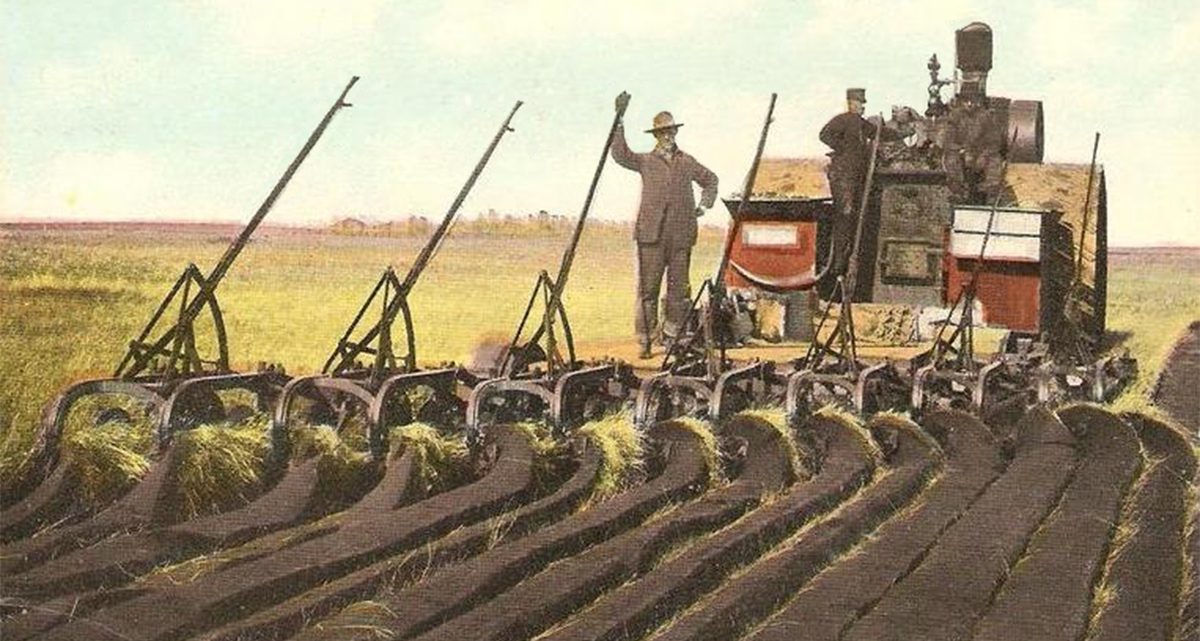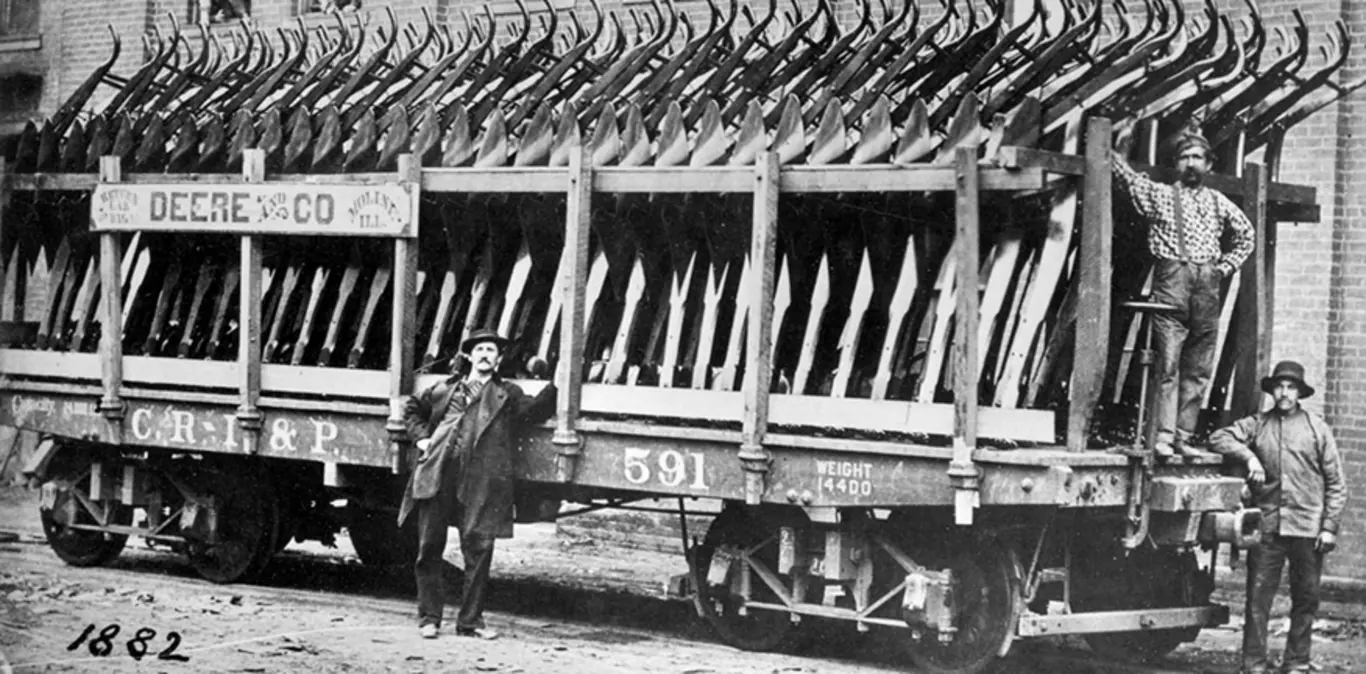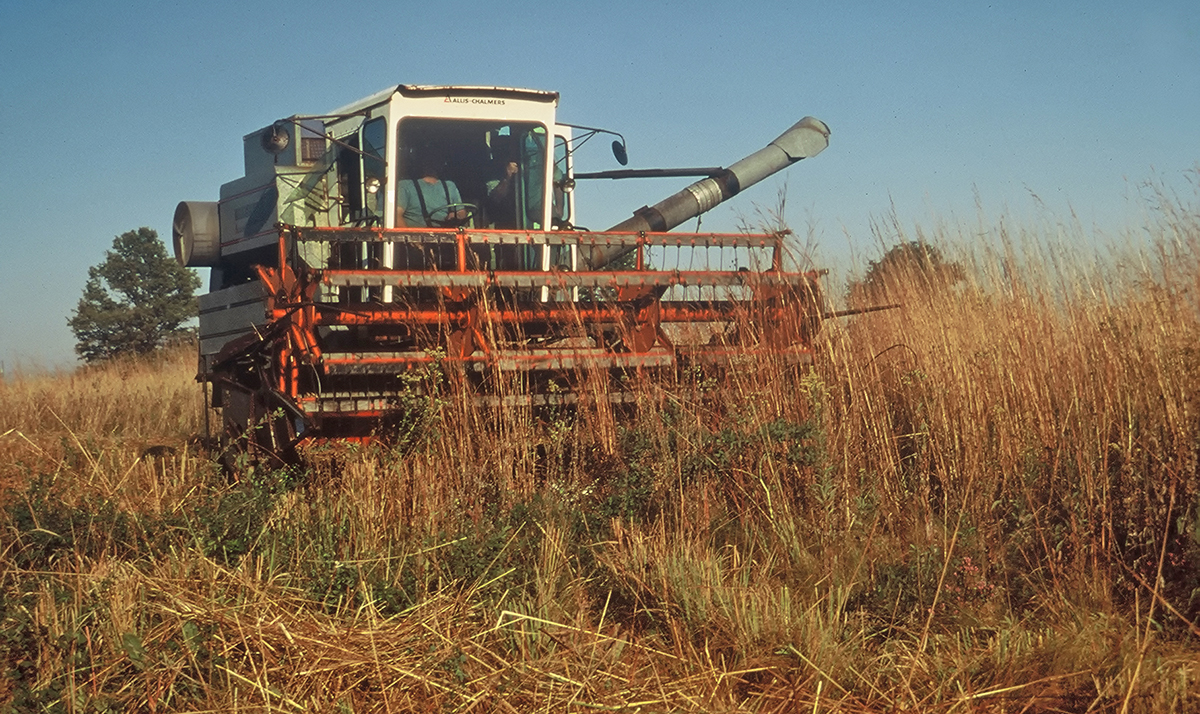GORDON MITCHELL and CARRIE MORROW
Metro Parks Resource Management
THE PRAIRIE PLOW THROUGH HISTORY (Gordon Mitchell)
Prairie Sod
When the American settlers first arrived at the midwestern prairies in the early 19th Century, they found the soil and vegetation to be much different than the soil and vegetation of the east. The eastern soils were light, sandy, and rocky. The soils of the midwestern prairies were much heavier, more loamy, and stickier than the soils of the east. The midwestern prairie vegetation consisted of tough grassed sod instead of the eastern forest trees.
The toughest grassed sods upon the prairies were the Big Bluestem (Andropogon gerardii Vitman), the Indian Grass (Sorghastrum nutans [L.] Nash), and the Prairie Cordgrass (Sporobolus michauxianus [Hitchcock] P.M. Peterson & Saarela. They all had deep, thick, and massive roots which were very difficult to break. Some of these roots extended down about 12-15 inches or more. Farmers usually waited until these grasses were green before plowing. This lessened the chance of the grass sprouting up again.
Cast-Iron Plow
Both cast-iron and wooden plows were used for the soils of New England. However, when these easterners arrived in the midwest, they brought plows with them. Charles Newbold of New Jersey invented a 1-piece cast-iron plow and received a patent for it in 1797. This plow had wooden handles and a wooden beam. Unfortunately, many early farmers were not interested because they feared the iron would poison the soil and would encourage weeds. Cast iron plows were brittle and broke easily if they hit a rock or a root. They also wore down easily and could not be welded back. If part of the plow broke, the whole plow was discarded and needed to be replaced. This would be costly to the farmer because it cost about two times more than a wooded plow. Because many early farmers preferred wood plows over cast-iron, Newbold spent about $30,000 trying to promote his plow.
David Peacock of New Jersey received a patent for his 3-piece plow in 1807. These three parts were the moldboard, the plowshare (cutting edge), and the landside (opposite side of the moldboard). Its three parts were all interchangeable and replaceable. Although his plow was an improvement over Newbold’s plow, Newbold sued him for copyright infringement and won $1,500 in damages.
Jethro Wood of New York and New England invented an improved cast-iron plow, also with 3-piece interchangeable and replacement parts. This plow had a steel-tipped plowshare. His first plow was patented in 1814 and was improved in 1819. It even worked upon some of the rockier soils. If part of the plow broke, it was possible to get replacement parts. His plows were cheaper and cost about $7-8 each. About 1,500 plows were sold in 1817, 1,600 plows in 1818, and 3,600 plows in 1819. Unfortunately, Jethro Wood spent most of his fortune prosecuting copyright infringements and died in poverty.
Cast iron plows grew in popularity from 1820 to 1835. All of these cast iron plows were on sale by 1825. They were sold in the midwest and in other states.
Plowing the prairies was a very difficult task. Every few yards, the farmers had to stop to scrape off the sticky soil from their plowshares and moldboards with a wooden paddle. This was both a time-consuming and a frustrating chore for them. Cultivating the prairies was very discouraging.
Cast-iron plows often required about 5-10 yoke of oxen and a crew of about three men to operate them. Many farmers hired plow teams to do their plowing. Some of these hired plow teams charged about $600 per acre. A good team could plow up to 3 acres a day. Clearing and farming forests back east was much easier and cheaper. Someone needed to come up with a better method of plowing.
Steel Plow
John Lane, Sr. of Lockport, Illinois, invented the polished steel, self-scouring moldboard plow in 1833. He used steel blades from sawmill saws. He plated the wooden moldboard and plowshare with strips of steel. This proved to be superior to the wooden or cast-iron plows. However, steel was scarce and expensive. Unfortunately, Lane did not patent or market his new invention.

John Deere was born in Rutland, Vermont. In 1821, he apprenticed as a blacksmith and was highly successful at it. In 1836, when New England’s economy collapsed, he moved to Grand Detour, Illinois, to avoid bankruptcy. In Illinois, he took up farming and blacksmithing.
John Deere may have also used saw blades. He probably placed a broken steel sawmill blade into a cast-iron plow. The blade was shaped concavely by bending it over a log. The moldboard was made of wrought iron and was polished upon its upper surface to prevent clogging by the soil. This was an improved self-polishing cast-steel plow. Steel was both lighter and stronger than cast-iron. Because of its success upon the prairies, it was nick-named the “Grasshopper Plow” or the “Singing Plow.”
It wasn’t long before John Deere began mass-producing and marketing his new plow. He made 10 plows in 1839 and 40 plows in 1840. In 1842, John Deere partnered with Leonard Andrus and started their company. In 1843, Deere used special rolled steel imported from England. However, thanks to the Bessemer process in the American steel industry, he later bought his steel from Pittsburgh. By 1846, John Deere was selling almost 1,000 of his cast steel plows per year. In 1848, John Deere dissolved his partnership and moved to Moline, Illinois, to open a factory. Moline was located near a railroad transportation hub along the Mississippi River. By 1857, John Deere’s factories were selling over 10,000 plows per year. Unfortunately, steel plows cost about 2½ times more than cast-iron plows.

In 1868, John Lane, Jr., received a patent for his 3-layered plowshare and moldboard of two thin outer plates of polished steel. This steel plow had a soft metal center to strengthen the plow and to reduce plow breakage. Unfortunately, some of John Deere’s steel plows did break in the field. That same year, John Deere incorporated his business into Deere and Company. This company was highly successful and still exists today.
METRO PARKS PRAIRIES (Carrie Morrow)
Metro Parks may not use a plow in its activities to manage and build parks, but there are certain farming techniques and equipment that are used! In the past several years, in the pursuit of preserving streams and other wildlife habitat, Metro Parks has acquired farm land. After the farm crop is harvested, either corn or soybeans, to restore the farm fields into the beautiful prairies and meadows, the use of farm equipment comes in handy.
To plant our fields, we use a truax seed drill. This machine, pulled by a tractor, allows two types of seed to be planted and has discs that disturb the surface of the soil to allow the seeds to sink into the top layer of earth. The seed mixes used are a prairie or meadow mix with a variety of native plants and a cover crop, like annual wheat, which will sprout quickly to protect the seeds in the ground from erosion.

It can take several years for prairie seeds to germinate. Metro Parks has also been using other equipment to harvest seed from our prairies to use in our restoration efforts. An old combine from the 1970s has been modified to strip the dried flower heads off the prairie plants. We then dry the seeds, clean them, and use them to plant new prairies. In a way, our restoration is a kind of modern “farming” to help bring back the habitats that existed prior to human intervention.
Prairie restoration primarily happens at Battelle Darby Creek and Prairie Oaks Metro Parks, although many of our other parks host demonstration prairies that promote the efforts in the western parks. These two Metro Parks are within the Darby Watershed and the historical Darby Plains Prairie Region. This prairie region used to cover more than 380 square miles in western central Ohio.
Bison have been reintroduced to some of the restored prairies at Battelle Darby Creek Metro Park. During the fall months you may see the combine harvesting the seeds or even groups of people hand collecting seeds in the prairies.

I appreciate the interesting articles that are written and shared. Thank you.